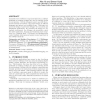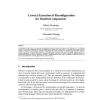184 search results - page 28 / 37 » Monitoring Atomicity in Concurrent Programs |
ACMMSP
2006
ACM
14 years 1 months ago
2006
ACM
Many people have proposed adding transactions, or atomic blocks, to type-safe high-level programming languages. However, researchers have not considered the semantics of transacti...
IPSN
2005
Springer
14 years 1 months ago
2005
Springer
Abstract— There is widespread agreement that a higher level programming model for sensor networks is needed. A variety of models have been developed, but the community is far fro...
AADEBUG
2005
Springer
13 years 9 months ago
2005
Springer
Increased reuse of software components has led to a software mishmash as existing packages are used as building blocks for new systems. Current debuggers cannot cope with the intr...
ENTCS
2010
13 years 7 months ago
2010
In component-based software engineering, reconfiguration describes structural changes to the architecture of a component system. For stateful components, not only structural but a...
ISSTA
2012
ACM
11 years 10 months ago
2012
ACM
Multithreaded programs are notoriously prone to unintended interference between concurrent threads. To address this problem, we argue that yield annotations in the source code sho...


